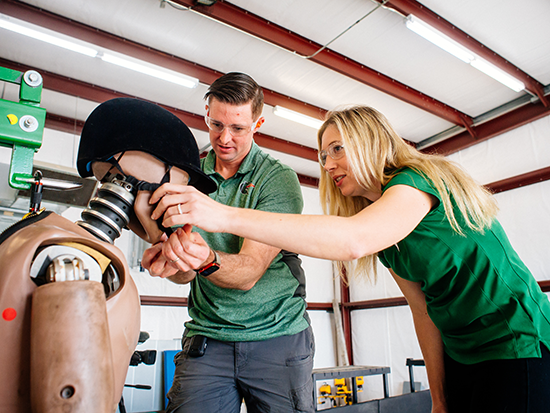Horseback riding is a great activity for the entire body. But as with all sports, injuries can happen when a rider falls or is thrown from a horse. In 2017 alone, more than 48,000 people were treated in hospital emergency departments for horseback riding injuries, according to the National Electronic Injury Surveillance System. Therefore, experts at the University of Alabama at Birmingham are sharing some of their injury-prevention tips for horseback riding this fall.
Wear a helmet
The most frequent cause of death or serious injuries among equestrian activities is head injuries. When a rider is on a horse, their head is estimated to be about 9 feet off the ground. That is why Sara Gould, M.D., an associate professor in UAB’s Department of Orthopedic Surgery, Division of Sports and Exercise Medicine, says riders should wear a helmet every time they ride.
Last year, Gould, along with Kevin Schrum, Ph.D., research scientist in the UAB School of Engineering, studied the efficacy of equestrian helmets. The study examined a standard equestrian helmet made from a polycarbonate shell over expanded polystyrene foam against newer helmet technology known as the Multi-directional Impact Protection System, or MIPS. The study looked at rotational velocity during head impact.
“We found a speed, angle and position of our test dummy where we could launch it off our apparatus and have it trip over a mechanism that would induce rotation and cause the head itself to hit the ground,” Schrum said. “We measured peak deceleration, duration of peak deceleration, peak rotational velocity and duration of peak rotational velocity.”
Rotational velocity occurs when the head hits the ground at an angle. The human brain has the consistency of gel. When the body goes one way and the head goes another way, the brain can be pushed into two different directions and the tissues may be stretched. This can lead to concussions, brain bleeds and damage to the axons in the brain.
“In our study, the MIPS helmets did not underperform; we just found that some of the less expensive helmets performed as well as the MIPS helmet,” Gould said. “We were able to test the helmets through the use of innovative technology that allowed us to place adult-sized manikins on a sled and launch them off the sled to imitate what a real fall from a horse looks like.”
Gould and her team were able to partner with Barber Motorsports Park and use technology commonly used in the automotive industry for this study. Her hope for the future is to be able to receive funding to research how falls from a horse can impact pediatric manikins.
“The bottom line is that, regardless of whatever type of helmet, wear a helmet,” Gould said. “We know wearing a helmet helps, and by not wearing a helmet, your risk for injury is exponentially greater.”
 UAB experts offer tips on staying safe while horseback riding.Work with an experienced instructor
UAB experts offer tips on staying safe while horseback riding.Work with an experienced instructor
In addition to testing helmets, Gould and her team are also exploring how a rider’s experience may also impact injury outcomes. While many injuries are due to the unpredictable nature of horses and actions of other humans, Gould says some injuries may occur due to equipment failure, lack of safety checks or lack of knowledge about how to safely handle horses.
“Research has shown that you are more likely to be injured if you have less experience riding horses, so working with a trained professional is very important,” Gould said.
One study states that approximately 100 hours of horse-riding experience are required to achieve a substantial decline in injury. Experienced riders have more knowledge about how to care for horses, how to handle horses in a safe manner, and the equipment and clothing one needs for riding. They can also teach beginning riders how to ride a horse correctly from the start.
Additionally, Gould says it is important to ride a suitable horse that aligns with a rider’s skill level. Beginner riders should ride well-mannered horses that are used to beginner mistakes. Riders should never ride alone and should always have a cellphone or two-way radio that can allow someone to call for help should an injury occur.
Minimize the risks of injury during falls
While taking steps to protect oneself while horseback riding, sometimes falls do still happen, so learning to fall safely is useful for riders at all levels.
“If you do fall from a horse, it is important to do the tuck and roll technique to try to minimize the risk of injury,” Gould said. “This technique can help protect those vulnerable areas such as the head, neck and wrist.”
To use the tuck and roll technique, the rider should let go of the reins and kick their feet from the stirrups; bring one arm around and across the body and avoid putting their limbs out to catch the fall; tuck their chin down to one side and toward the chest; and aim to take the impact on their shoulder. After landing, the rider should roll themselves clear until they are away from the horse. After falling, the rider should assess themselves for injuries and seek medical attention if needed.